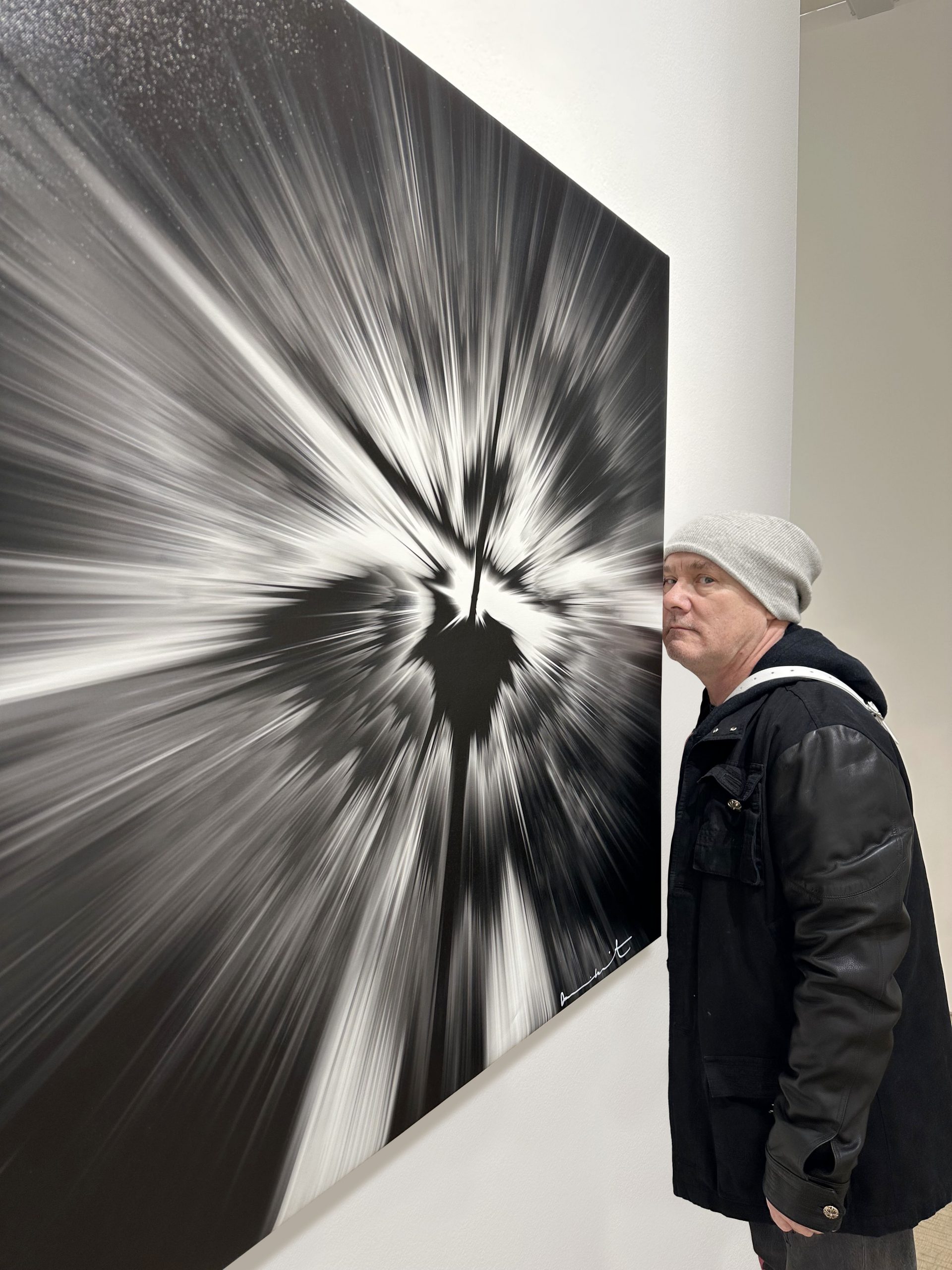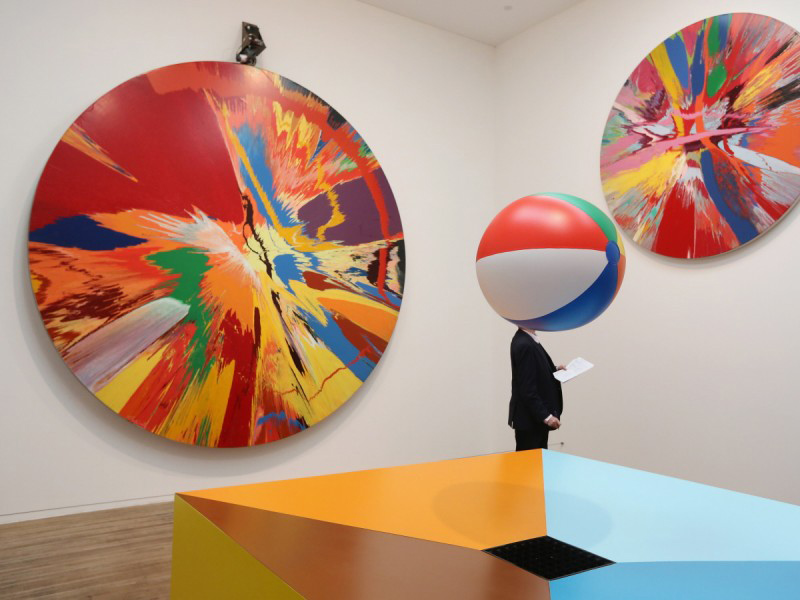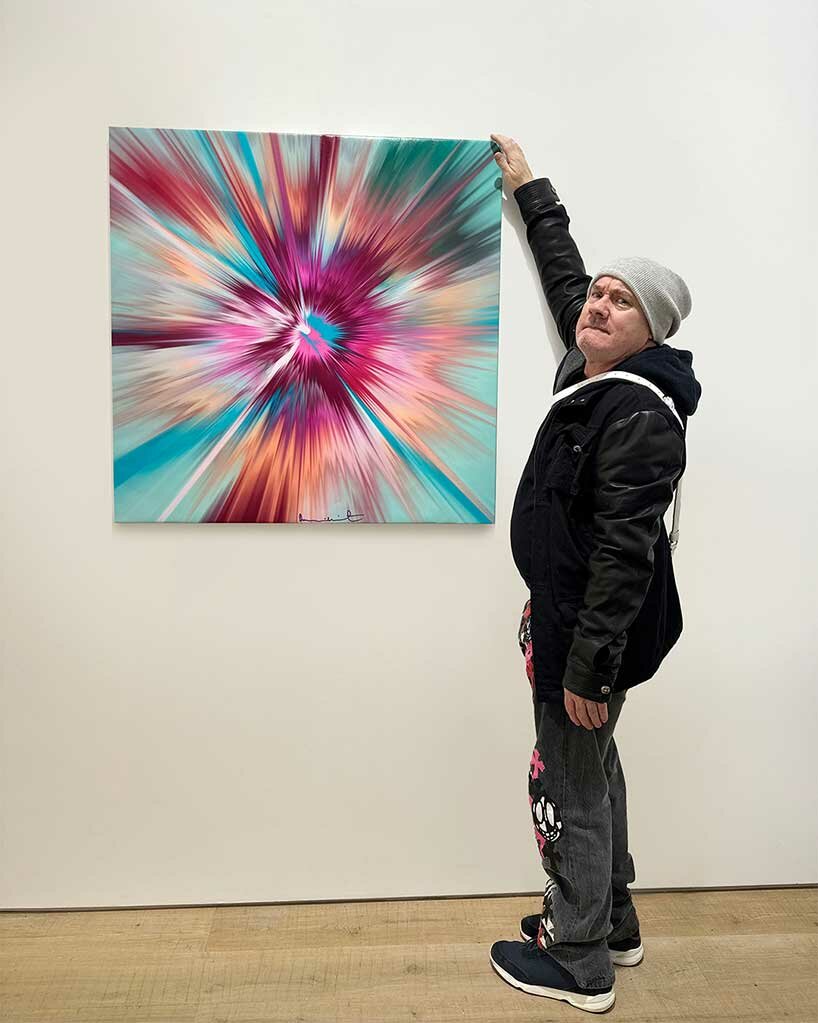Damien Hirst’s spin paintings are among the most instantly recognizable and exuberantly playful works in contemporary art. Bursting with color, energy, and movement, these pieces have been celebrated, commercialized, and critiqued in equal measure since their debut in the mid-1990s. But beneath their centrifugal swirl lies a complex dialogue between artistic intention, childhood memory, mechanical process, and deeper philosophical questions about authorship, randomness, and meaning.
This article explores the origin of Hirst’s spin paintings, unpacks their conceptual layers, and examines how they can be interpreted within the broader context of his work and the trajectory of modern and contemporary art.
Origins: From Childhood Toy to Conceptual Art
The idea behind Damien Hirst’s spin paintings can be traced back to both personal and historical sources. Hirst has often cited the children’s spin art toy — a simple machine commonly found at school fairs, where paint is dripped onto a spinning surface to create abstract patterns — as a key inspiration. He was fascinated by the way the spinning mechanism removed the artist’s hand from the outcome, creating beauty through motion and chance.

Hirst first began experimenting with spin paintings around 1992, but it wasn’t until 1994, while working in Berlin, that he formally introduced the series to the public. The early works were created using household gloss paint on circular wooden boards. These paintings reflected a growing interest in mechanical systems, detachment from traditional mark-making, and the interplay of order and chaos — themes already central to his contemporaneous “Spot Paintings” and “Medicine Cabinets.”
In the years that followed, Hirst installed a spin machine in his studio and began producing large-scale versions of the works. In 2002, he took the concept further by inviting the public to create their own spin paintings at interactive booths in London’s White Cube gallery and later in New York. These participatory installations blurred the lines between artist and audience, fine art and entertainment.
Technique and Execution
Hirst’s spin paintings are made by affixing a canvas or panel to a rotating platform and applying paint while it spins at high speed. Centrifugal force throws the paint outward, creating radial, splattered, and sometimes surprisingly symmetrical patterns. Sometimes paint is poured freely; in other cases, syringes or squeeze bottles are used to inject color with more precision.
Though the machine handles the movement, the process isn’t entirely random. Hirst still makes creative decisions before and during the act — including the color palette, thickness and consistency of the paint, the type of brush or applicator used, and the spin speed. The final composition is therefore a collaboration between intention and chance, control and chaos.
Materials vary across the series: early works used glossy household paint, while later spin paintings employed acrylics, enamels, metallic pigments, and even diamond dust. The result is a body of work with intense visual appeal — glossy, vibrant, and seemingly manufactured, yet deeply rooted in conceptual art traditions.

The Influence of Dada, Duchamp, and Chance
One of the most important conceptual themes in the spin paintings is the embrace of chance — a hallmark of 20th-century avant-garde movements like Dada and Surrealism. Marcel Duchamp, whose “readymades” redefined what art could be, was a key influence on Hirst. Duchamp’s 3 Standard Stoppages (1913–14), which captured randomness as a form of measurement, parallels Hirst’s fascination with letting go of control.
The spin paintings also echo Jackson Pollock’s drip paintings in their emphasis on physical movement and abstract energy. But where Pollock’s work foregrounds the artist’s physical gesture, Hirst’s spin works remove the artist from the action altogether, outsourcing creativity to the machine. This mechanical intervention challenges traditional ideas of authorship, artistic skill, and uniqueness.
This conceptual game — art made by process rather than hand — raises broader questions: Can beauty emerge from randomness? If anyone can make a spin painting, does the artist’s identity still matter? Hirst uses the machine to push these questions to their logical extremes.
Meaning: Color, Energy, and Existential Cycles
At first glance, Hirst’s spin paintings feel joyous and energetic. Their bright colors, kinetic compositions, and circular symmetry evoke a childlike sense of fun. This aesthetic charm has made them among Hirst’s most commercially successful works, appealing to both serious collectors and casual admirers alike.

But as with much of Hirst’s work, darker undertones emerge beneath the surface. The circular format, for example, can be read as a metaphor for life cycles, repetition, and even death. The explosive movement of paint can suggest violence, disintegration, or chaos — all recurring themes in Hirst’s practice.
Some paintings carry intentionally provocative or ironic titles, like Beautiful, childish, expressive, tasteless, not art, over simplistic, throwaway, kid’s stuff, lacking in integrity, sensational, low technique, big, nothing that matters… painting (1996). These titles critique both the art world’s perception of the series and Hirst’s own ambivalence toward its reception.
Psychologically, the spins can evoke euphoria, anxiety, or spiritual transcendence. Their disregard for traditional composition mirrors a rebellion against academic painting. Yet, at the same time, the works’ vibrant appeal and polished finish flirt with pure visual pleasure. In this sense, they straddle two worlds: one of intellectual critique, the other of aesthetic indulgence.
The Spin Paintings in Hirst’s Larger Body of Work
The spin paintings occupy a unique place within Hirst’s broader artistic journey. Alongside the “Spot Paintings,” they form part of his ongoing investigation into seriality, repetition, and detachment. Yet while the Spot series reflects pharmaceutical order and clinical detachment, the spins are chaotic, physical, and emotive.

They also reinforce Hirst’s role as both artist and showman. He has performed spin painting live at art events, collaborated with musicians like U2, and even used the aesthetic in product lines and merchandise. This pop-culture crossover recalls Andy Warhol and his Factory — blurring boundaries between high art, mass production, and consumer culture.
Through this lens, the spin paintings serve not only as art objects but as conceptual provocations: What defines an original? Can art be entertaining and still be taken seriously? What happens when art becomes brand?
Damien Hirst’s spin paintings may look spontaneous, even whimsical, but they are grounded in serious conceptual concerns. By inviting randomness into the creative process, Hirst continues the lineage of Duchamp, Warhol, and Pollock, while making a bold statement about authorship, beauty, and the commodification of art.
Whether viewed as decorative eye candy, high-concept irony, or playful experimentation, the spin paintings challenge viewers to rethink the role of the artist, the purpose of painting, and the value of chance in creation. They are not just colorful spectacles — they are spinning, whirling meditations on what it means to make art in an age of machines, markets, and mass participation.


